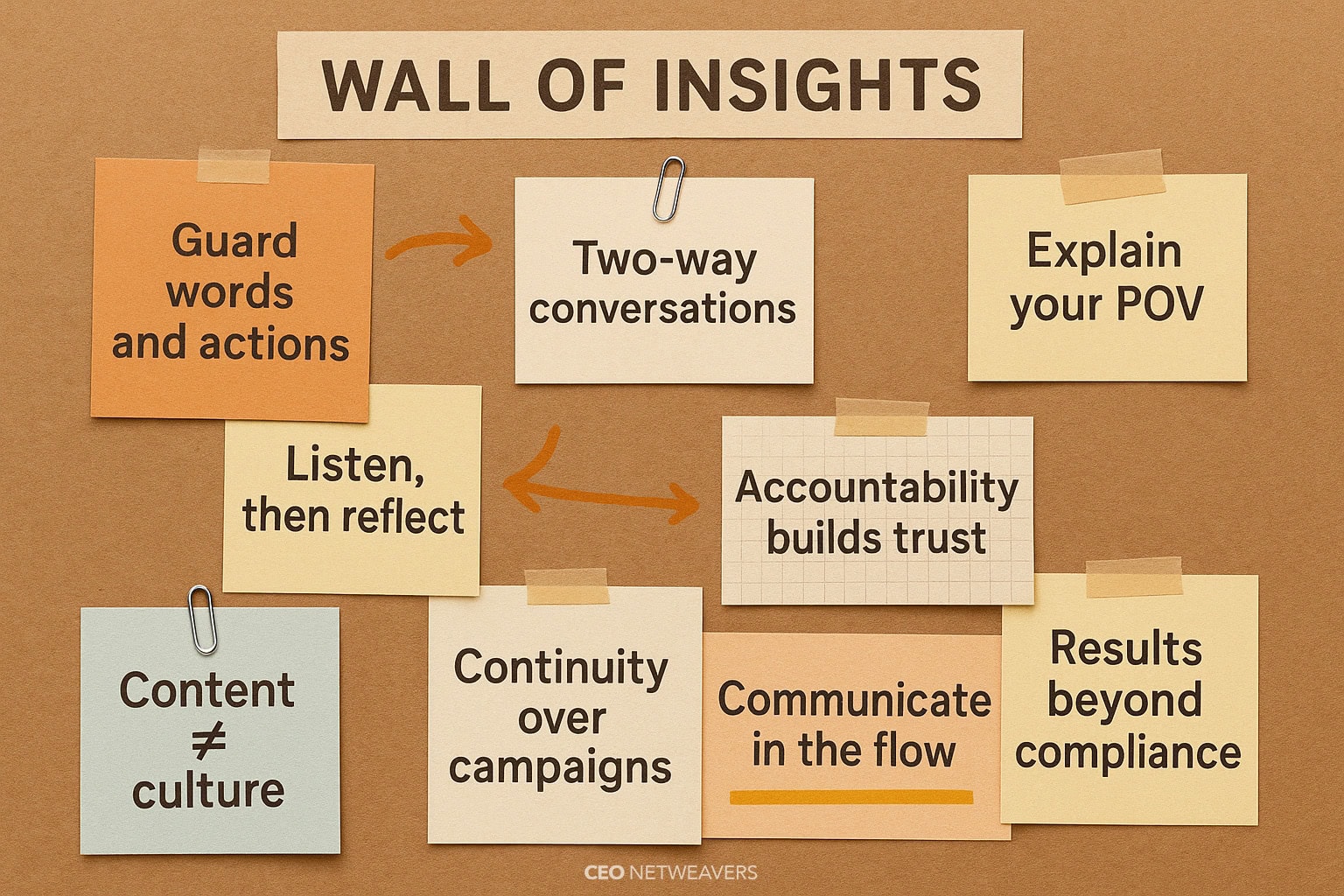Conflict at the top doesn’t sink companies. Unmanaged behavior does.
That’s the clearest takeaway from Stephen M. Paskoff, Esq.—Founder, President, and CEO of ELI, Inc.—in his talk for CEO Netweavers on navigating conflict within executive teams. His message is plain: if you want faster decisions, higher accountability, and a leadership bench people want to join, you have to operationalize how you and your team disagree.
I can tell you Paskoff’s framework maps directly to what separates high-performing executive teams from the rest. Below is a summary of his approach covered during our session, with field-tested additions you can put into play immediately.
Key Takeaways
- Behavior is the operating system of executive conflict. The law is a minimum, not the goal.
- Anchor disagreements in common purpose and observable norms.
- Use a conversational rhythm (JUST TALK) to compress misreads and drive closure.
- The Five C’s—Commitment, Communication, Content, Consequences, Continuity—turn values into daily practice.
- If you ignore it, you approve it. Recognize and correct with equal intensity.
When the CEO isn’t bought in, make it matter with business outcomes and build a lighthouse team.
What Most Teams Miss About “Executive Conflict”
Healthy conflict is not a vibe. It’s a system. The mistake many leadership teams make is treating disagreement like a personality mismatch or a legal risk to be avoided. Paskoff argues the opposite:
- The law sets a floor, not a standard of excellence.
- Your values, norms, and daily behaviors set the ceiling.
He offered an early exercise that reframes the room. Instead of starting with differences, he asked leaders to identify commonalities.
The energy changed instantly. Smiles. Momentum. Trust.
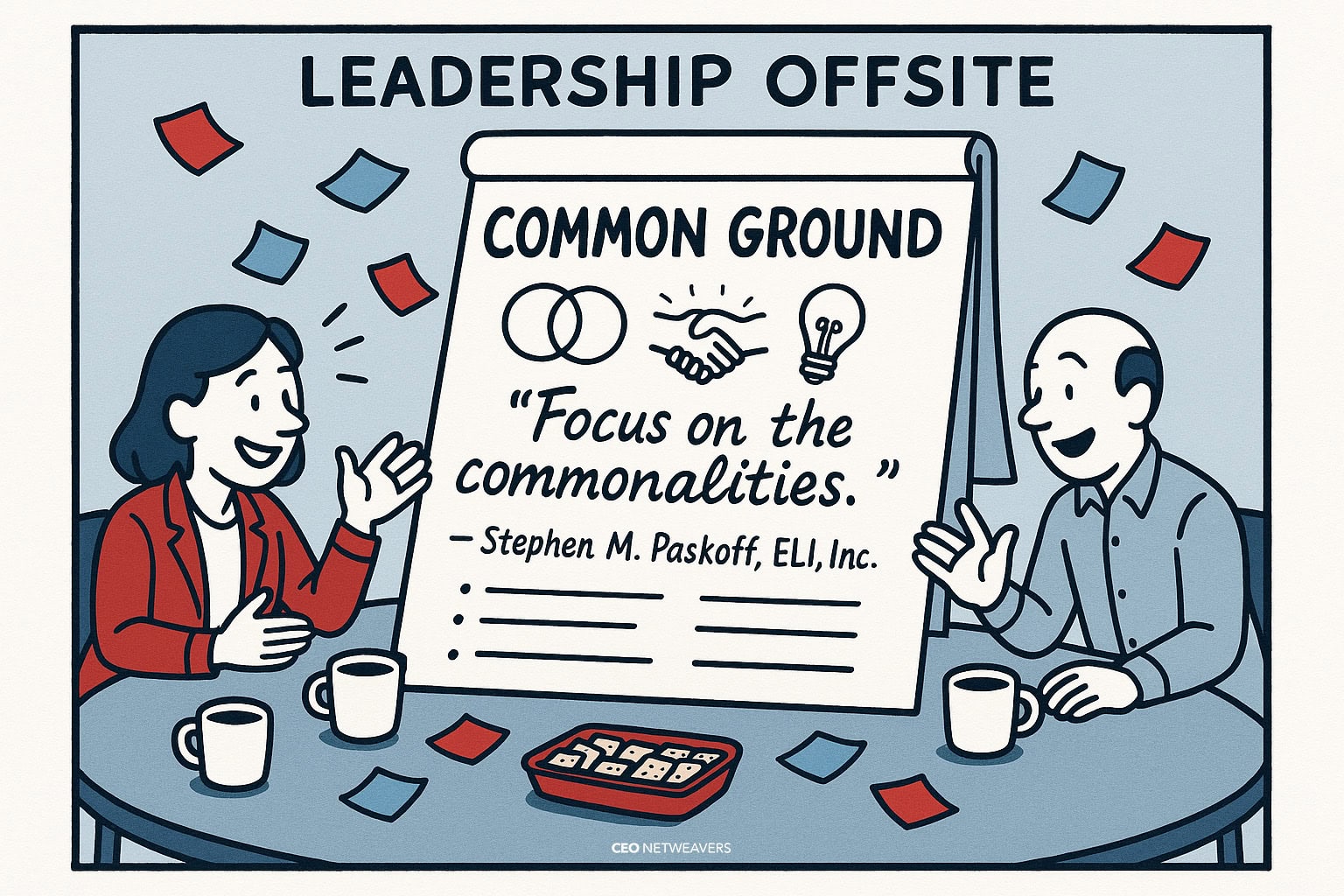
Why? Because shared purpose resets the context for hard conversations. As he puts it, focus on the commonalities… all of the things around it that are different are seen in the context of what you share.
In practice, that means anchoring executive debate to mission, strategy, and operating principles—before you get into the weeds of “who’s right.”
A Behavior-First Lens: Beyond “Is it legal?”
One of Paskoff’s most powerful stories involves world-class surgeons whose conduct routinely degraded team performance. No one questioned their technical skill. The issue was behavior: yelling, dismissing input, and creating an environment where anesthesiologists hesitated to speak up. The impact wasn’t theoretical—it was operational, cultural, and in some cases, tragic.
His point: the worst outcomes rarely begin as legal violations. They start as tolerated behaviors that erode attention, clarity, and courage. As he says bluntly,
it’s not a lack of knowledge that’s the problem. It’s the lack of action and doing.
For growth leaders, translate that to revenue and product velocity:
- Fewer people speaking up → Fewer early warnings → More rework, higher burn
- Dismissive interactions → Slower cross-functional collaboration → Slower releases
- Inconsistent consequences → Political decision-making → Lower trust, higher attrition
This isn’t “soft stuff.” It’s throughput, quality, and speed.
The Triangle of Risky Behaviors (and Why You Must Act Earlier)
Paskoff describes a simple hierarchy of conduct risks:
- Illegal behavior (the tip)
- Abusive or bullying behavior
- Dismissive or unwelcoming behavior
- Rude or exclusionary behavior
- “I’m-just-focused-on-results” behavior that ignores values
Most teams only mobilize when something becomes a legal issue.
But by then, trust is already depleted and influence points are lost. The occupational hazard of the executive floor is confusing “high standards” with “high pressure without respect.”
Behavior change starts well below the legal threshold.
The Two-Minute Exercise Every Executive Should Run
Paskoff invited one participant to write—privately—how they wanted to be treated at work.
After a minute, he seals the card and says he’ll never read it. Why? Because too many leaders act as if individual preferences don’t matter; only results do.
Then he asks the obvious question: Who wants to work with that leader?
No hands go up.
This is the pragmatic pivot.
Results and relationships are not trade-offs. They’re codependent. Teams that win consistently do both: they set a high bar and protect the conditions where people can deliver.
Action for your next exec offsite:
- Ask each leader to articulate, in one minute, “How I do my best work” (feedback preferences, meeting norms, decision expectations).
- Share only the highlights.
- Codify two team norms that respect the widest array of preferences while keeping velocity high.
- Revisit quarterly.
The “JUST TALK” Conversational Loop
Great executive teams disagree in structured ways. Paskoff offers a simple loop that mirrors what I’ve seen in high-performing GTM and product orgs:
- Explain your point of view
- Listen with intention
- Check for understanding
- Plan next steps
- Circle back with appreciation
This is not a script. It’s a rhythm. It forces clarity on inputs, compresses misinterpretation, and creates a shared record of next steps. Notice the reciprocity: both parties speak, both parties paraphrase, and both parties leave with concrete actions.
A practical tweak I recommend:
- Timebox each exchange: 3 minutes to present, 2 minutes to reflect back, 2 minutes for clarifying questions.
- Then decide: align, escalate, or timebox a follow-up.
Velocity requires closure.
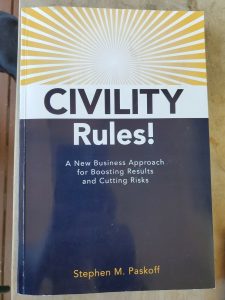
The Five C’s That Make Civility Operational
Paskoff’s operating system for behavior change is the most useful part of his framework. He calls it the Five C’s:
- Commitment
This isn’t a one-off training or a poster. It’s leadership behavior, repeated. Paskoff is clear: if you won’t consistently model the standard, don’t expect anyone else to. Commitment looks like:
- CEO and C-suite referencing behavior standards in weekly business reviews
- Leaders calling out—and thanking—healthy dissent in the moment
- A standing agenda item to inspect norms alongside metrics
- Communication
Talk it out. Don’t rely on long email threads that invite tone misreads and passive-aggression. Paskoff notes the “unconscious bias” of digital interpretation—how we project tone into text. When stakes are high, use your voice and your face. Then summarize in writing to confirm decisions and owners.
- Content
Policies and values statements are necessary but insufficient. Make your expectations actionable. Replace mushy values with behavioral examples:
- “Respect” → “We don’t interrupt. We ask clarifying questions before disagreeing.”
- “Accountability” → “The decision-maker names the DRI and deadline in the meeting.”
- “Transparency” → “We write it down. We publish decisions in the operating log.”
- Consequences
Paskoff’s rule is non-negotiable: if you ignore it, you approve it. That cuts both ways.
- Positive: Recognize leaders who model healthy conflict under pressure.
- Corrective: Coach, document, and—if behavior doesn’t change—exit, regardless of performance in other areas.
- Continuity
One-and-done is theater. Operational change is a marathon. Bake these checks into existing rituals:
- Weekly exec meetings: 5-minute “norms check” (what went well, one improvement)
- Monthly skip-levels: pulse on safety to speak up
- Quarterly survey: two questions on voice and trust; trend it
This is inexpensive and high leverage. It’s how you “make it stick.”
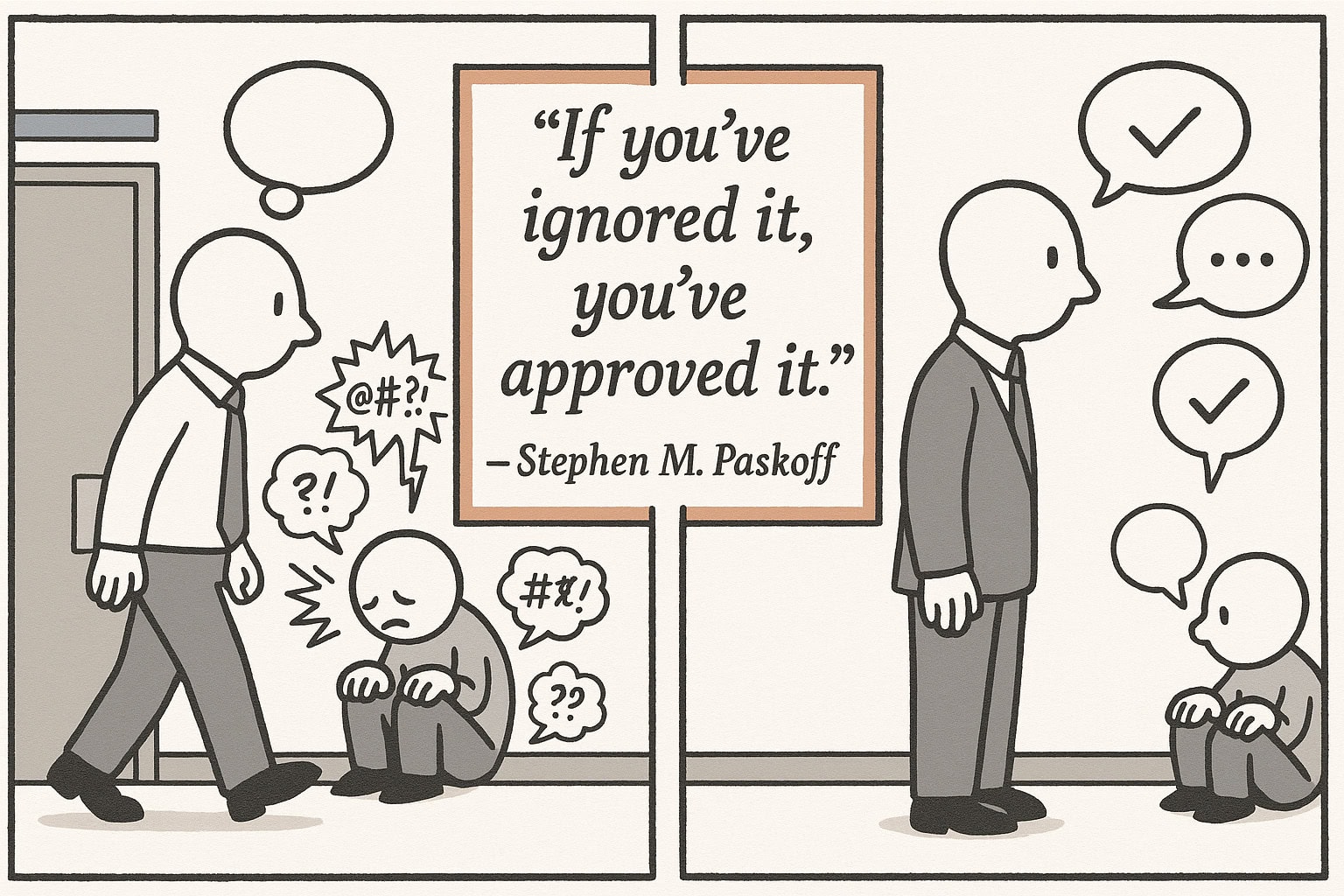
Speak Up and Listen: The Dual Responsibility
Paskoff emphasizes that speaking up and listening are a pair. It’s not enough to “give people space to talk.” Executives must demonstrate reflective listening—repeating back the core point in neutral language and asking, Do I have that right?
He told a story about a colleague responding to his ideas with I receive it. Absent shared context, those words felt dismissive. Only later did he learn the phrase had deep meaning to her. How did he learn what she mean? He stepped into healthy conflict, and he told her how he was interpreting what he was hearing. Then, he asked if that was her intention.
Two lessons for leadership teams:
- Intention doesn’t trump perception. Clarify quickly.
- Language carries history. When in doubt, ask what a phrase means to someone.
A simple practice to adopt this week:
- When conflict emerges, have each party summarize the other’s position before offering a rebuttal. No summary, no response.
It’s surprising how fast this de-escalates tension and surfaces real disagreements (as opposed to misheard ones).
Measurement Without Bureaucracy
A common question during the session: how do we measure whether we’re actually getting better at this?
Paskoff’s guidance tracks with what works in GTM:
- Short pulse surveys (3–5 questions) run quarterly
- Volume and nature of internal complaints and skip-level themes
- External signals: regrettable attrition, cross-team cycle time, post-mortem themes
- Focus groups when signals spike
Instrument lightly. Inspect relentlessly. If the numbers are flat, don’t add a new program—upgrade leadership behaviors first.
When the CEO Isn’t Bought In
A leader asked the hard scenario: what do you do when the CEO or power center isn’t committed to this work?
Paskoff doesn’t sugarcoat it. Cultural change is hardest when the top won’t model the standard. He offers two angles that I’ve also found effective:
- Make it matter in business terms. Tie behavior to safety, quality, customer retention, or on-time delivery. Show the cost of silence and the drag of rework. Use case studies from your industry to make the risk real.
- Build a lighthouse team. If you own a function, operationalize these principles inside your org. Publish your norms, recognize behavior, and measure lift (faster releases, fewer escalations, higher retention). Positive results create pull.
If nothing shifts after you’ve made it explicit and tied it to outcomes, you have your answer. The best leaders won’t stay where their voice is unwanted and values are optional.
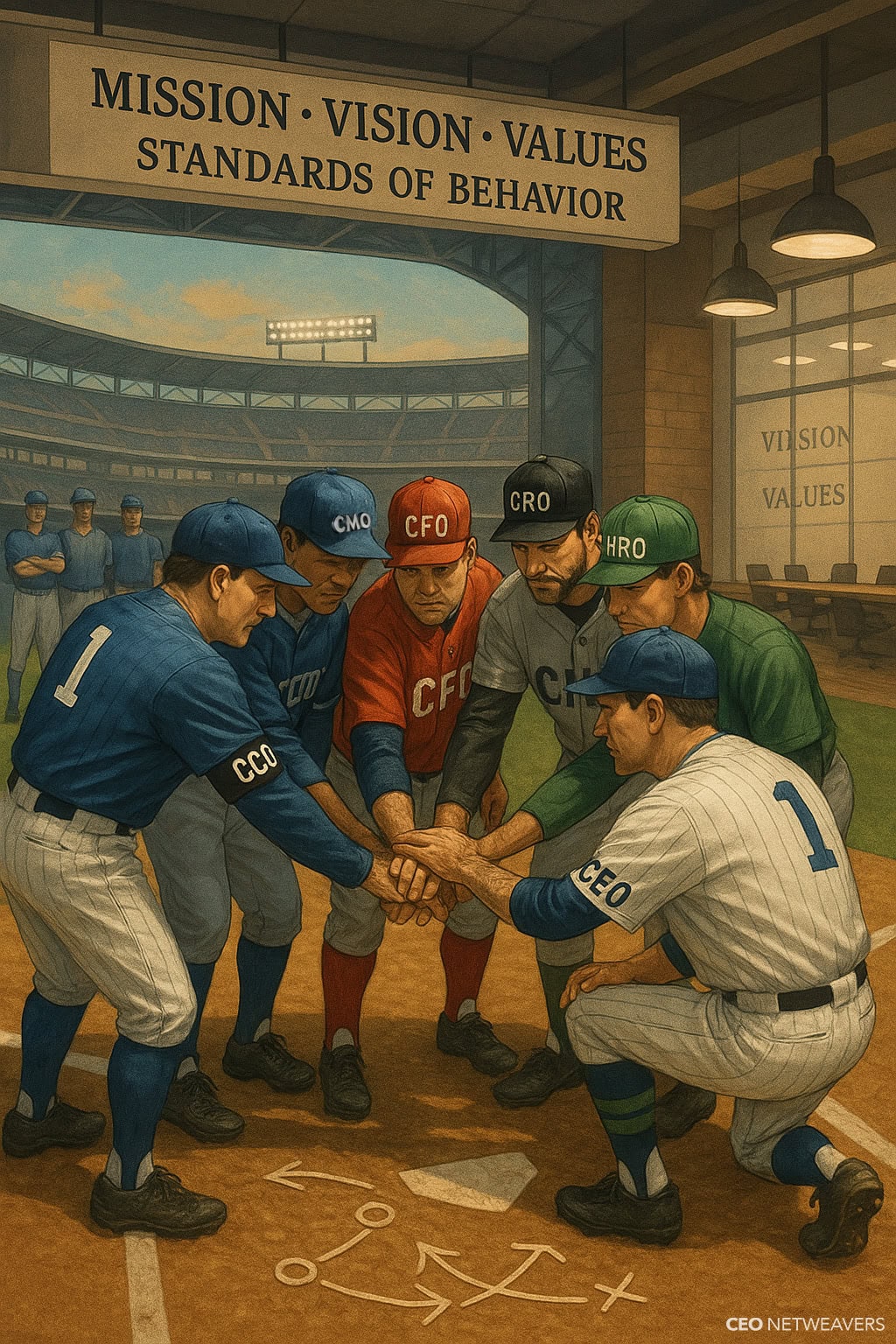
Sports Analogy That Actually Helps
Paskoff closes with a baseball image: players from rival clubs wearing the same jersey for the All-Star Game, celebrating together after a win. The day before and after, they compete fiercely. For that game, they’re on the same team.
In companies, we don’t have the luxury of “just one night.” We’re wearing the same jersey all year. That’s why the standard has to be higher. The principle still holds: define the common goal, agree on how we’ll work together, and then compete hard on ideas.
The Executive Conflict Playbook (Put This to Work in 30 Days)
You don’t need a reorg or a six-month transformation program. You need a clear operating system and the discipline to run it.
Here’s a 30-day plan pulled from Paskoff’s model and what’s worked for my teams across B2B SaaS, marketplaces, and real estate platforms.
Week 1: Set the Standard
- Publish the Five C’s as your executive team’s behavior contract, adapted to your language.
- Define three observable behaviors you expect in high-stakes conversations (e.g., no interruptions, one “steelman” summary before rebuttal, DRI and deadline named in-meeting).
Week 2: Train the Rhythm
- Teach the JUST TALK loop in a 45-minute live session. Practice with real disagreements.
- Adopt “record and confirm”: one person posts a 5-bullet recap in your operating log after each debate. Decisions, owners, deadlines, open risks.
- Choose one conflict ritual for moments of heat: a 90-second pause to write, then return to speaking.
Week 3: Instrument the System
- Launch a 4-question pulse survey to your direct reports and skip-levels:
- I feel safe raising a dissenting view with senior leaders.
- Senior leaders model respectful debate in high-pressure situations.
- Decisions are clear and documented after debate.
- I know how to escalate when alignment stalls.
- Baseline the number of “reopened decisions” and cross-team escalations this quarter.
Week 4: Enforce and Recognize
- Catch leaders doing it right—publicly thank them with specifics: “You paused, summarized Finance’s position, and changed course based on new data.”
- Coach misses early and in private. Document the expectation, the gap, and the agreement to improve. If behavior doesn’t change, escalate consequences.
- Share early wins: faster decision on pricing, fewer escalations in a sprint, improved engagement score on “voice.” Make it matter.
That’s it. Four weeks. Measurable shift.
Language That Lowers Heat (and Still Moves Fast)
Try these in your next exec debate:
- “Here’s the decision we need to make, the deadline, and the decision-maker. Let’s run three options fast.”
- “Let me play back what I heard. Tell me if I’m missing anything.”
- “I’m going to disagree with the approach, not your intent. Here’s my data.”
- “This is a values issue, not a legal one. Our standard is higher.”
- “We’re stuck. DRI for a 48-hour deep dive, then we reconvene for a final call.”
And when you notice behavior off-norm:
- “We agreed on ‘no interruptions’ during data shares. Let’s reset.”
- “We’re reading tone into email. Let’s take this live and summarize after.”
Short. Neutral. Action-oriented.
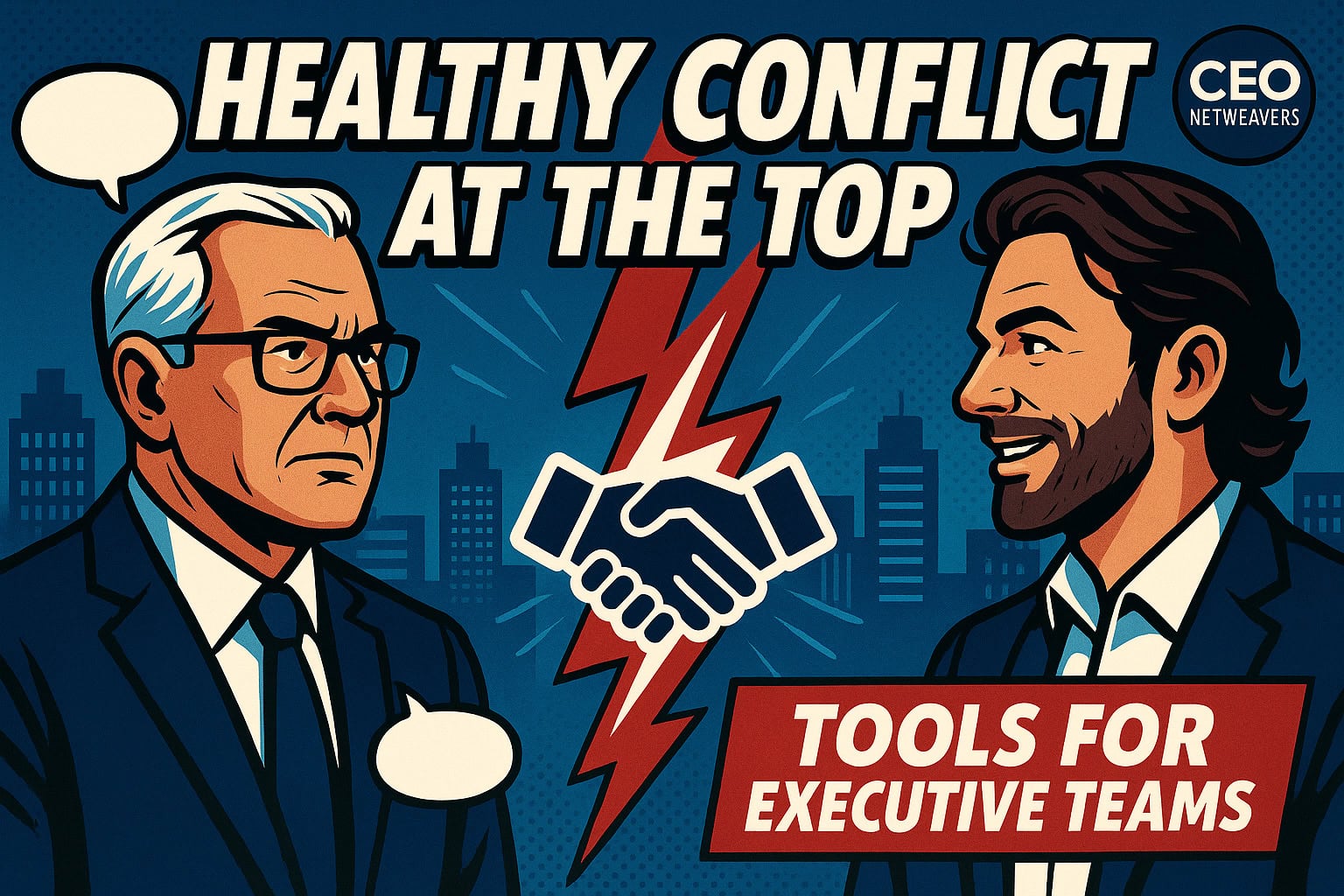
Executive Scripts for Hard Moments
- When a senior leader bulldozes debate
“Pause. We need both speed and signal. We’re going to hear Ops for 3 minutes uninterrupted, then you’ll get the same time. We’ll decide in 10.”
- When someone refuses to capture decisions
“We decided X and Y. I need a 5-bullet summary in the operating log by EOD. If it’s not there, we’re not done.”
- When a top performer violates norms
“I value your results. The way you pushed in the room broke our standard. That erodes trust and slows us down. I’m coaching it once. Next time, it’s formal.”
- When the team misreads tone in writing
“We’re projecting tone. Let’s take it live in 15 minutes. After, we’ll document the call.”
- When you’re not the CEO and tension is building
“My org is adopting three norms starting today: no interruptions, steelman summaries, and decision logs. We’ll share metrics monthly. If you want the lift we’re seeing—faster cycle time, fewer escalations—I’m happy to walk through the system.”
Guardrails for Digital Communication
Paskoff warns about the bias of email and chat. Here’s a simple protocol that preserves speed without sacrificing civility:
- If a message creates heat or confusion, escalate the medium: chat → video → in person.
- State your intent upfront: “I’m flagging a risk, not assigning blame.”
- Use “decision memos” for major calls: the question, the options considered, the decision, owners, deadlines.
- Ban sarcastic or performative comments in shared channels. They’re a tax on trust.
Remember his baseline: some words and behaviors permanently erode trust when published. Don’t post them. Don’t tolerate them.
Consequences Are Culture
You get the culture you consistently reward, tolerate, or exit.
Paskoff frames it directly: Commitment without accountability yields less commitment. If a leader crushes results and crushes people, they are a short-term asset and a long-term liability. Great companies act accordingly.
A practical checklist for consequences:
- Do we recognize healthy dissent publicly at least weekly?
- Do we coach misses privately within 24–48 hours?
- Are repeat violations documented?
- Have we exited at least one high-performing values violator in the past 12–18 months?
If you’re 0-for-4, your people already know your actual standard.
Why This Matters Now
Hybrid work amplified misreads, increased async communication, and shortened tempers. At the same time, competition is faster, customer expectations are higher, and most mid-market companies are trying to do more with leaner teams.
Healthy conflict is now a competitive advantage:
- Better ideas surface sooner
- Decisions happen faster
- Execution is cleaner
- People stay longer
High-performance is not “nice.” It’s relentlessly clear and deeply respectful.
A Final Word from the Field
High-performing companies define the behaviors, practice the rhythm, instrument lightly, and enforce consistently. They don’t wait for HR or an annual training day. They build the muscle in the flow of work.
Paskoff’s session distilled that truth with urgency and clarity.
My recommendation: adopt his Five C’s, teach JUST TALK, and set consequences. In 30 days, you’ll feel the difference. In 90 days, you’ll see it in your numbers.
